Dewsbury, Ossett and Soothill Nether Tramways
History
This short, 3.14-mile, standard-gauge, overhead electric tramway was jointly owned by the corporations of Dewsbury (0.2 miles) and Ossett (1.14 miles), along with Soothill Nether Urban District Council (1.8 miles).
Powers to construct a tramway linking Dewsbury and Ossett had originally been acquired by the promoters of the Wakefield and District Light Railways in 1902, but no progress was made, the powers eventually lapsing due to the tramway not having been completed within the stipulated 3-year timeframe. The lack of progress eventually resulted in the aforementioned local authorities taking matters into their own hands, and after seeing off another proposal from the commercial sector — the Dewsbury and District Light Railway — they successfully acquired powers to build a municipal tramway in 1904, Soothill Nether UDC on the 22nd July, and Dewsbury and Ossett Corporations on the 15th August.
However, and for reasons which are not entirely clear, there followed a long hiatus before anything concrete materialised. The councils involved presumably needed to borrow money to build the tramway, and there was no doubt a lot of discussion about whether they would operate the tramway themselves or lease it to a company. There were two obvious candidates, namely, the Yorkshire (Woollen District) Electric Tramways Company, which was a subsidiary of the British Electric Traction Company, and the Yorkshire (West Riding) Electric Tramway Company, both of which already had termini in the area, the former in Dewsbury and the latter in Ossett. Although discussions were held, neither was prepared to offer terms agreeable to the councils, though the Y(WR)ETCo came tantalisingly close in 1906; at least one of the sticking points was the requirement to operate a branch line to Earlsheaton, which neither company thought would be remunerative. In the end, the councils chose to accept an offer from the National Electric Construction Company to build the tramway (the councils paying for this) and then operate it under a lease arrangement.
The NECCo was initially set up as an electrical installation concern, but branched out into tramway construction and operation, and would eventually have a stake — either as owner or operator — in the following systems: City of Oxford Tramways (1907-1914); Mexborough and Swinton (1907-1929); Musselburgh and District Tramways (1904-1928); Rhondda Tramways (1908-1934); and Torquay Tramways (1907-1934).
Construction finally started in late spring 1908, the tramway opening circa seven months later on the 12th November 1908. The system consisted of a main line running eastwards from a terminus in Dewsbury Market Place, through Chickenley Heath, then southwards at the Flying Horse Inn in Ossett Side Street, to a terminus in Ossett Market Place; just to the east of Dewsbury, a branch line ran southeastwards along High Rd to a terminus in Town St, Earlsheaton. Although the northern terminus was only a matter of yards from the system operated by the Y(WD)ETCo, no connection was ever made between the two. At the southern end, although the tracks of the DO&SNT were connected to those of the Y(WR)ETCo, regular through running was never implemented (despite many discussions over the years), only the occasional rugby or Sunday School special being allowed to venture over the other system's tracks.
Ownership of the tramway was simplified in 1910 when Soothill was absorbed by the municipal borough of Dewsbury, the latter from then on owning 2.0 miles of the 3.14-mile system.
The tramway was the most badly impacted of any tramway system in the country during the Great War, when judged in terms of the percentage of staff that it lost to the armed services. This naturally impacted maintenance as well as services, many of the latter undergoing drastic pruning, much to the chagrin of the councils, who were quick to complain, even though the NECCo, like many other tramways, had no obvious solution.
The conflict also brought a significant increase in passenger numbers, which had reached 2.9 million by 1920, only dropping by circa 10% during the troubled years of the early-to-mid 1920s, then rising to over 3 million in 1929. The increased takings certainly helped the company finish its rather protracted and half-hearted tramcar top-covering programme, begun in 1915 and finally completed in 1925.
Profitability was greatly helped by the absence of post-war motorbus competition, the DO&SNT not having to contend with this until the comparatively late date of 1931. The company had in fact tried to introduce motorbus services of its own to supplement the heavily overcrowded trams, but was perversely refused permission by Dewsbury and Ossett councils. With the tramway structure ageing, the company attempted to persuade the councils to abandon the system and allow them to run replacement trolleybuses; the company was probably in no hurry to force the issue as its lease still had a staggering 20 years to run (until 1950) and the infrastructure was after all, the councils' property. The first moves in this regard were made in 1930, with detailed plans following, which were still on the table as late as June 1932.
Events, however, were to put paid to the trolleybus scheme, the NECCo and all its tramway operations, including the DO&SNT, being taken over by the British Electric Traction Company on the last day on 1931. Whilst the BETCo was content to leave the NECCo's tramway subsidiaries to their own devices, the DO&SNT was different in that it had always been operated directly by the NECCo. The BETCo therefore handed operation over to its local subsidiary — the Y(WR)ETCo — which by this time, was itself already set on a course of tramway abandonment. The Y(WR)ETCo already operated a substantial motorbus fleet, with modern depot infrastructure, so it was probably no surprise to anyone when the NECCo's trolleybus replacement plans were quietly dropped in favour of motorbus replacement.
Powers to abandon the tramway — under the Dewsbury and Ossett Passenger Transport Act — were obtained on the 28th June 1933, the last trams running on the 19th October 1933. The Ossett route of the Y(WR)ETCo had already succumbed 15 months prior to the DO&SNT abandonment on the 25th July 1932, the Y(WD)ETCo following suit one year later on the 31st October 1934.
Overall, the DO&SNT carried an impressive number of passengers over many years, despite being a very small system without any meaningful through-running, and was, to the credit of the owners and the lessee, operated efficiently and profitably for its entire existence.
Uniforms
Good quality images of DO&SNT motormen and conductors with their tramcars are surprisingly rare, however, all is not lost, as no fewer than four excellent staff photos have survived, an astonishing number for such a small system. These photographs allow for a fairly detailed understanding of the uniform chronology.
Motormen were provided with double-breasted lancer-style tunics with five pairs of buttons (narrowing from the top to the bottom of the tunic, and probably plain with a scalloped rim), epaulettes (with button closures) and stand-up collars. In the early years, the bearer's right-hand collar appears to have carried metal letters ending in '…T Co', which were in all likelihood system initials: probably 'D & O T Co', even though no such company existed, the tramway being operated directly by the NECCo. In later years, although motormen continued to wear lancer-style tunics, the epaulettes were dispensed with.
Conductors were initially issued with double-breasted jackets with five pairs of buttons and lapels; curiously, the latter do not appear to have routinely carried insignia, though there were exceptions, the odd individual wearing system initials on the their right-hand collar. At some point, probably in the mid 1920s, a change was made to single-breasted jackets with five buttons, two breast pockets (with button closures), stand-up collars and epaulettes (with button closures); whilst some photos show conductors wearing 'D & O T…' initials on their left-hand collars, the vast majority were left plain.
Caps for both grades were in peaked with a tensioned crown (top); they carried a standard, off-the-shelf, script-lettering grade badge, either 'Motorman' or 'Conductor'. It is currently unclear whether the badges and buttons were brass or nickel.
Tramcar crews were also provided with double-breasted greatcoats with five pairs of buttons and high fold-over collars; these garments did not bear any insignia.
Although far from certain, it does not appear that a switch was made to British Electric Traction Company uniforms following the latter's takeover over the National Electric Construction Company in 1931.
Inspectors were issued with single-breasted jackets edged in a finer material than the main body, with hidden buttons — or more likely a hook and eye affair — two slit breast pockets and stand-up collars; the latter carried the grade 'Inspector' in embroidered script lettering. At some point, probably in the late 1920s or early 1930s, new jacket issues came with epaulettes. Caps were initially of the drooping peak type with a pom pom on top, later being changed to a more peaked style with a tensioned crown, probably around the time of the Great War; both styles carried the bearer's grade — 'Inspector' — in embroidered script lettering, almost certainly on a hat band.
In common with the vast majority of UK Tramway systems, women were employed as conductresses during the Great War to replace men lost to the armed services. Photographs of these ladies are. however. yet to surface, so until they do, details of the uniforms they wore remain unknown.
Further reading
For a detailed history of the Dewsbury, Ossett and Soothill Nether Tramways, see 'The Tramways of Dewsbury and Wakefield' by W Pickles; Light Rail Transit Association (1980).
Images
Motormen and conductors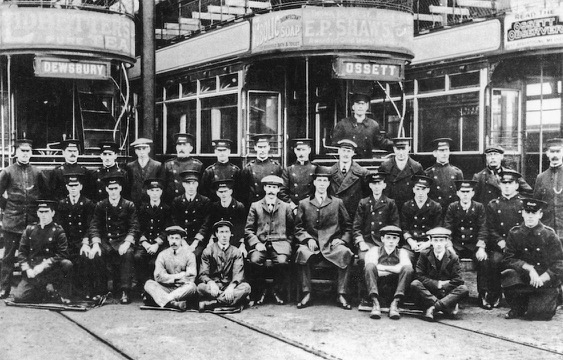
A staff photo taken at the depot in Church Street, Ossett — photo undated, but probably taken not too long after the opening in 1908. Author's Collection.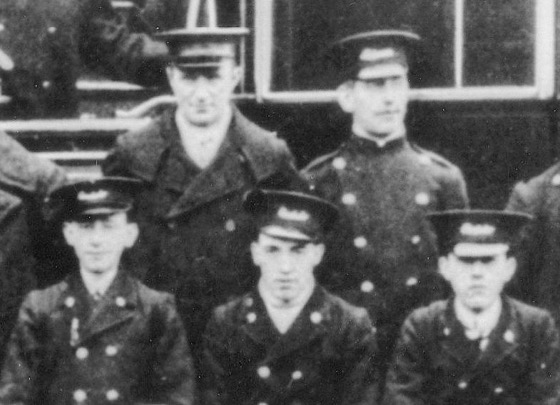
An enlargement of the above photograph showing several conductors (in double-breasted jackets with lapels) and a motorman (top right, in a double-breasted lancer-style tunic). The cap badges are standard, off-the-shelf, script-lettering grade badges, either 'Motorman' and 'Conductor'.
General pattern script-lettering grade badges of the type used on Dewsbury, Ossett and Soothill Nether Tramways tramcar-crew caps. It is currently unclear whether they were issued in brass or nickel.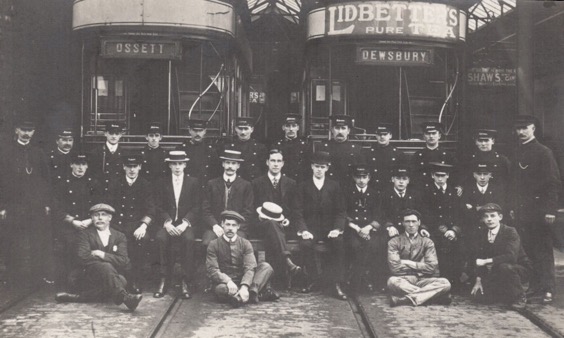
Another Church St staff photo, probably taken a little later than the previous shot, but certainly before the Great War. The motorman third from the right is James Birley (born 1880), who would later become an inspector on Scarborough Tramways, a photo of him there having survived (see link). Source unknown.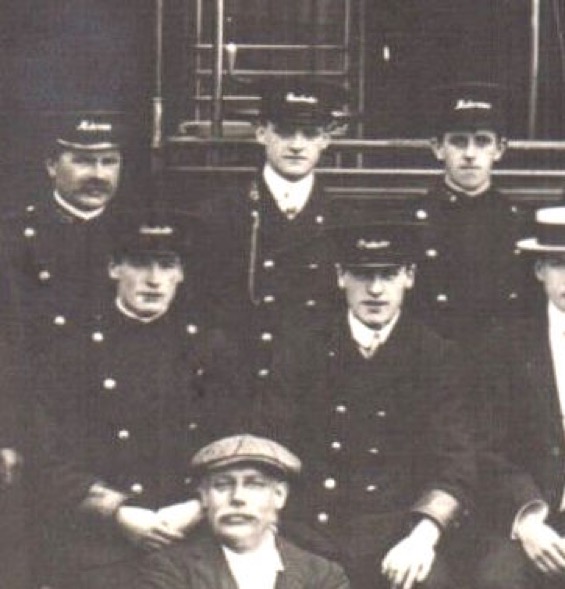
An enlargement of the above photograph showing two conductors (in the centre on the middle and back rows) and three motormen (in lancer-style tunics). Although difficult to make out, the motormen certainly have initials on their right-hand collars ending in 'Co'. Curiously, most conductors in the photograph appear to have plain collars, the individual in the centre on the back row (above) being the exception.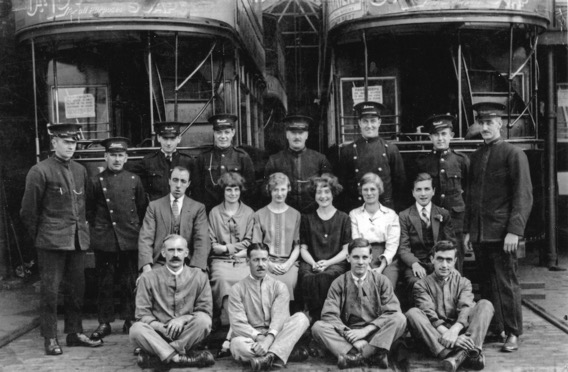
An assemblage of three inspectors, two motormen, two conductors, fitters and clerical staff at Church Rd depot — photo undated, but probably taken in 1929 or 1930. Author's Collection.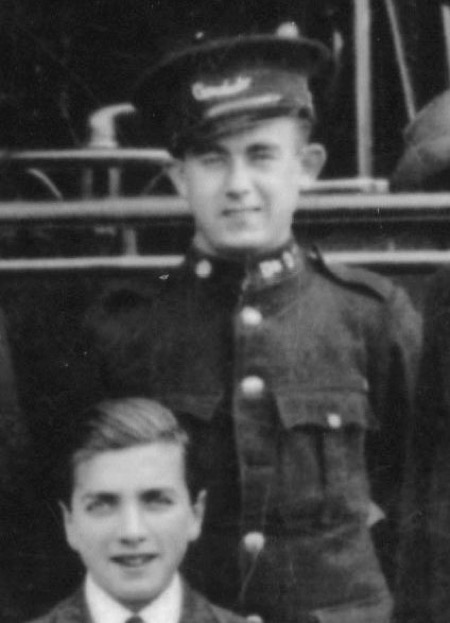
An enlargement of the photograph above showing one of the conductors, who by this time were wearing single-breasted jackets with stand-up collars and epaulettes. The subject's left-hand collar carries individual system initials: 'D & O T…'. Of the other three tramcar crew, one appears to have the same collar designation, whereas the remaining two have plain collars.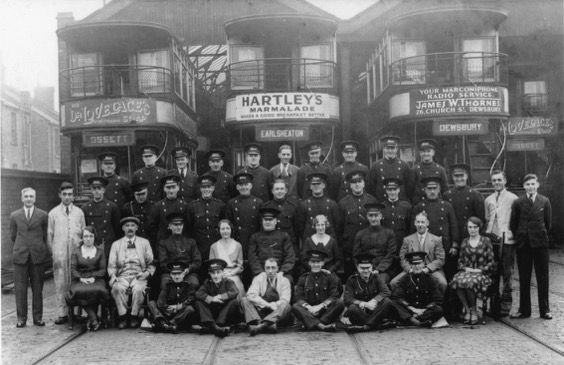
Another Church St depot shot, again taken in the early 1930s, possibly directly before closure in 1933. Author's Collection.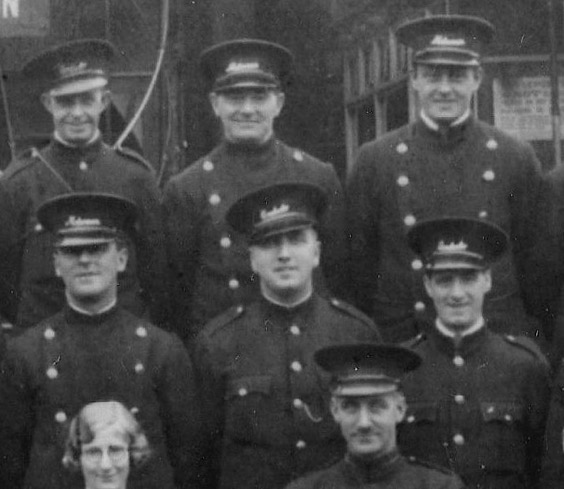
An enlargement of the above photograph showing several conductors (in single-breasted jackets with epaulettes) and motormen (in double-breasted lancer-style tunics without epaulettes). In contrast to the previous photograph, none of those depicted have collar badges, possibly reflecting the fact that it was taken after the DO&SNT had been handed over to the Y(WD)ETCo (1st January 1931).
Senior staff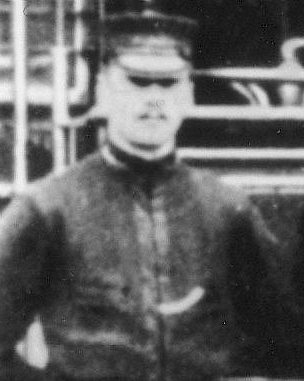
An enlargement of the early staff photograoh above showing one of the inspectors. He is wearing a fairly standard tramway inspector's jacket with his grade (presumably) embroidered on his right-hand collar (and possibly the left too), along with a drooping-peak cap with pom pom on top, also bearing his the grade.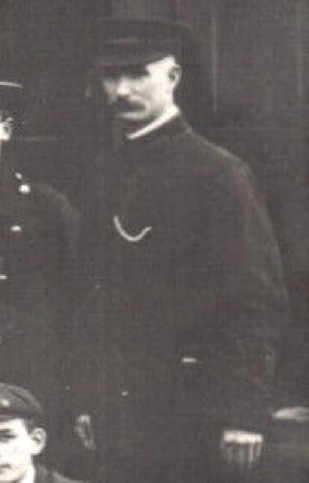
A blow-up of the pre-Great War photograph above showing one of the inspectors, in very similar uniform, but now with a more modern tensioned-crown peaked cap.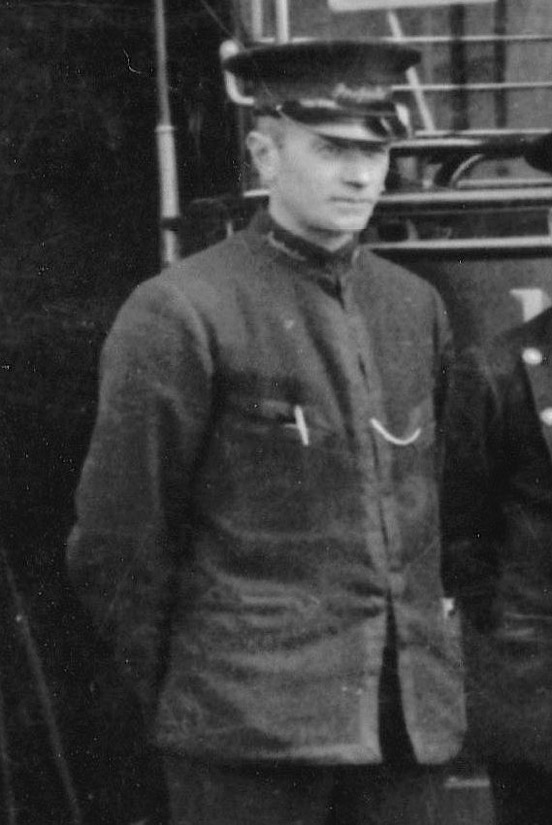
An enlargement of the early 1930s staff photograph above showing one of the inspectors. The collars and the cap all bear the grade — 'Inspector' — in embroidered script lettering.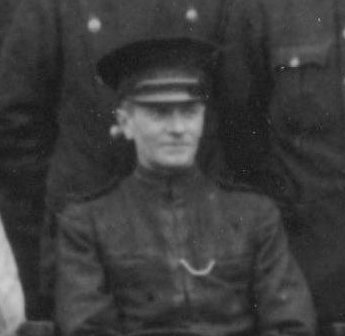
A blow-up of the 1933 photograph above showing one of the inspectors, who may possibly be James Birley, who returned to the DO&SNT after his stint as an inspector on Scarborough Tramways. The jacket now bears epaulettes.